Whilst they might not be among the most successful sides in the Swedish women’s game, there is no doubting that BK Häcken Dam are a Damallsvenskan powerhouse, with them consistently competing at the top flight’s summit and being a near-permanent fixture in the Champions League.
What makes that level of consistency even more impressive is that it has come despite key assets departing whenever the transfer window opens.
This summer has been no different in that regard, with no less than four players opting to move on mid-season to pastures new (three of them to the WSL, with Sweden duo Anna Sandberg and Rosa Kafaji joining Manchester United Women and Arsenal Women, respectively, while Tanzania forward Aisha Masaka has linked up with Brighton and Hove Albion Women).
Häcken could be forgiven for feeling the effects of that disruption, but what prevents that from happening is their ability to keep plugging the gaps left open by those who move on.
New signings and those left behind combine to ensure that the team can keep playing with the same momentum as before.
One player who will be vital in that happening this time around is Felicia Schröder.
She might still be just 17 years old but is already a regular fixture in the first team, with her arguably being the first name on their teamsheet at this moment in time.
With nine league goals to her name so far this year (and two assists), her quality is there for all to see, and this tactical analysis will take a closer look at why Häcken value her so highly and why she has all the makings of being a star of the future.
Felicia Schröder Style of Play – Fitting Into The BK Häcken Dam Model
What is immediately noticeable when watching Häcken play is that there is a style that runs through everything they do, with a clear strategic blueprint that every player or coach who joins the team needs to adhere to.
When watching Felicia Schröder style of play, there is no doubt that she matches a lot of those tactical demands, which is why it is likely that she will become an even more important player for them as the campaign goes on.
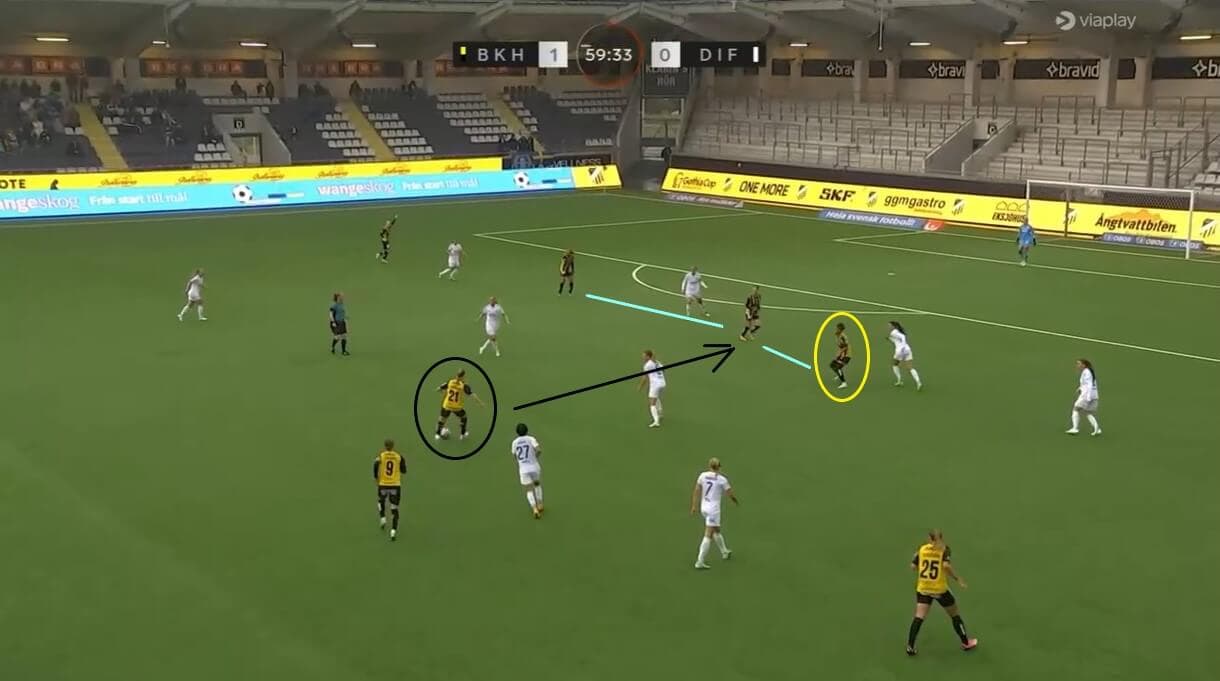
The first thing to highlight within that is the reliance on wide threats whenever they move into the final third, and it has been seen in matches during the tenures of both current head coach Mak Lind and that of his predecessor Robert Vilahamn (who left a year ago to take charge of Tottenham Hotspur Women) that the lead striker can at times act as a pivot whilst two others either side make runs off them to create passing options between and behind the opposing defensive line.
It has not been so common to see under Lind, with his preferred 4-2-3-1 formation not allowing it as easily as Vilahamn’s inside forward structure, but there have been times when it has proven its use and has enabled them to test their opponents’ resolve.
The match against Djurgårdens Damer was one of those.
The visitors were a side capable of catching opponents out on the counterattack but not the most secure defensively (as was highlighted in a recent match against Brommapojkarna Dam), so Häcken knew that applying pressure was the best way to approach this encounter.
Whilst the striker’s role in this is critical, it is the two wide forwards who really make this a very effective strategy.
Their ability to time their runs and get behind the pivot point early allows the ball to keep progressing up the field.
In this case, the speed of the sequence of passes from Denmark midfielder Jóhanna Fossdalsá to Canada forward Clarissa Larisey (who has largely been the main target player in the extended absence of another Denmark international, Stine Larsen) and then into Schröder ensured that Djurgårdens were unable to either become compact or to move up and to break the attack down prematurely.
The chance might not have come off on this occasion, but the threat that Schröder posed in this sequence cannot be doubted.
Her becoming highly proficient at making runs into spaces and exploiting gaps is one reason that Häcken will be heavily reliant on her moving forward.
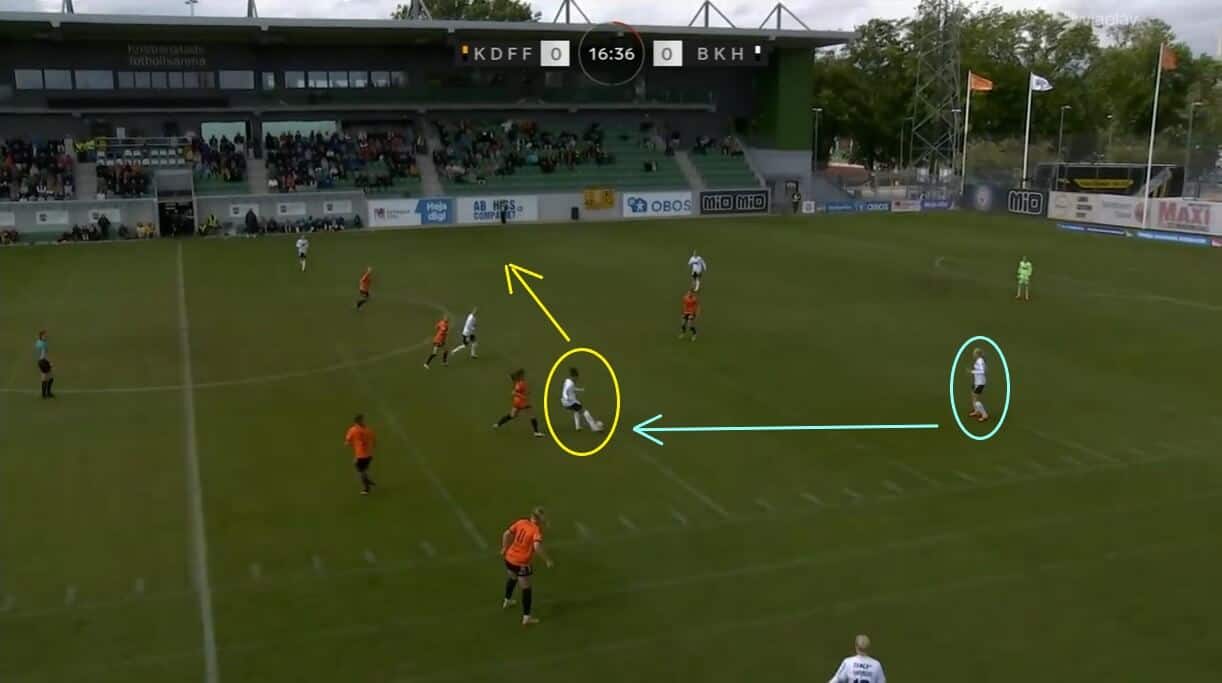
That desire to construct well-executed passing sequences is another key aspect of Häcken’s tactics, and Lind has made no secret of his desire for the team to build through the thirds whenever they are in transition.
As a result, there has been a constant need for players to be positionally flexible and to drop into different spaces around the field in order to allow the ball to be shifted around in an efficient manner.
This is something else that Schröder has really thrived at.
Here, she drops back into her own half and acts almost as a holding midfielder, receiving the ball directly from defender Lisa Löwing before sending it across the field and into the space that Kristianstads Dam has left open.
It might be argued that this horizontal pass is not very progressive and doesn’t tally with those aforementioned transitional demands, but it is actually the right decision to make here, given the pressure Schröder is under from behind, and it shows how she makes good decisions with the ball at her feet.
In this case, she knew that turning and looking up the field would have risked giving away the ball, so she didn’t hesitate to be conservative.
For that reason, 60.4% of her passes have found their intended targets so far in 2024.
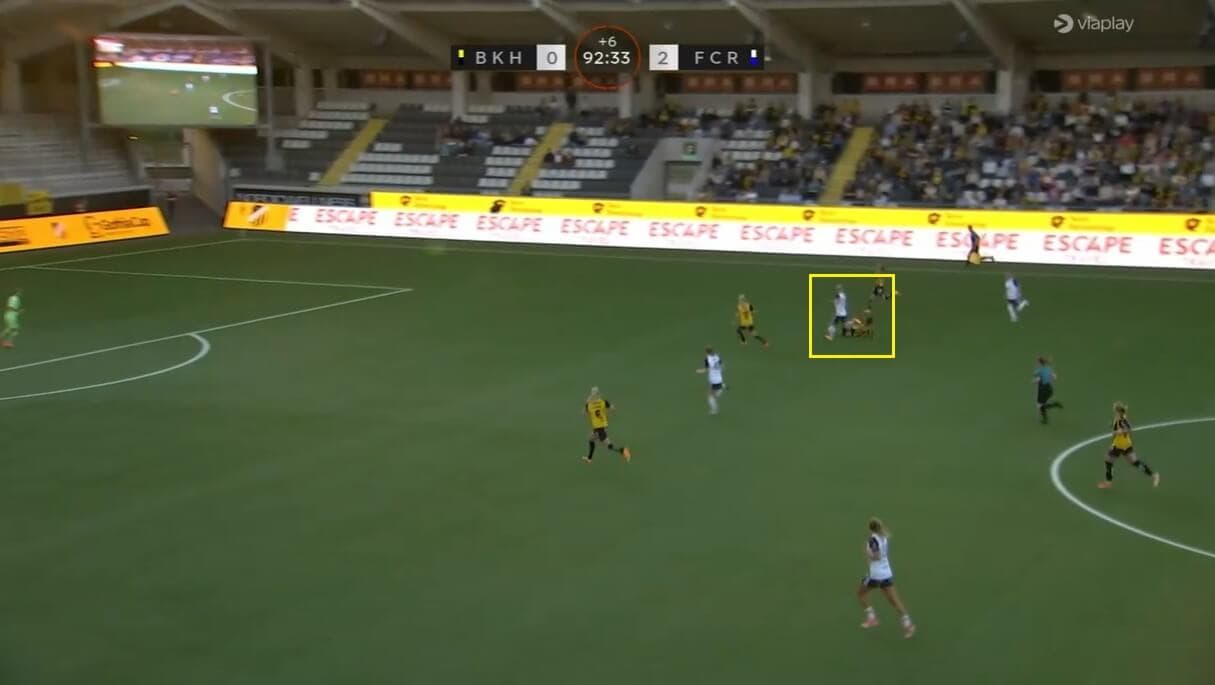
She also plays a key role when Häcken lose possession, with their desire to control the flow of the game meaning that they need players around the pitch who can react quickly to prevent opponents from building their own momentum whenever they have an opportunity to do so.
In this case, Rosengård Damer have sought to do just that with a typically speedy attack, and it appears as though they have caught Häcken out, but to think that way would be to discount the presence of Schröder.
Her pace allowed her to run at Rosengård captain Caroline Seger from behind here and to dislodge the ball cleanly.
The fact that she has succeeded in 58.5% of her defensive duels, despite being someone who normally operates inside the final third, indicates just how well-suited she is to so many aspects of Häcken’s game plan.
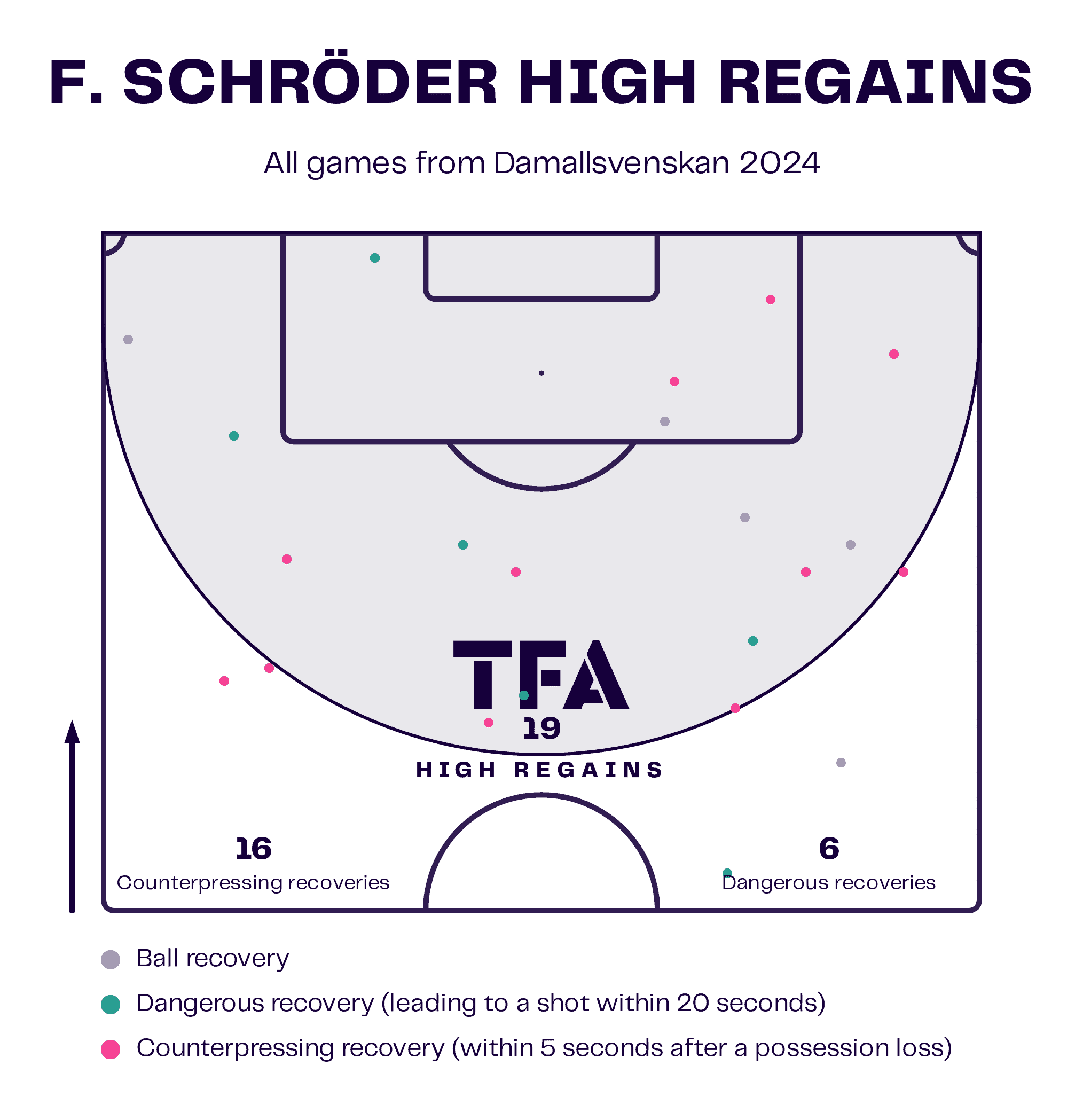
It is worth noting, though, that Schröder’s defensive capabilities don’t only come alive when her side are under threat inside their own third.
She also proves her use higher up the pitch.
As this graphic indicates, she has been responsible for 16 of Häcken’s counterpressing recoveries so far.
A number of those have come in and around the goal area, further proving her desire to never allow opposing sides to build any momentum.
Therefore, when combining everything that she offers, both with and without the ball, it is clear that her presence has been critical in Häcken’s averaging 57.54% possession per game so far in 2024 and conceding just 0.76 times per outing.
Felicia Schröder Attacking Threat
Despite her obvious usefulness in many different aspects of Häcken’s play, there is no getting away from the fact that Felicia Schröder is an attacker by trade and so is at her best when among the front line or in an offensive role.
However, she has shown to be strong in more than scoring goals, and once again, her offerings are rich in variety.
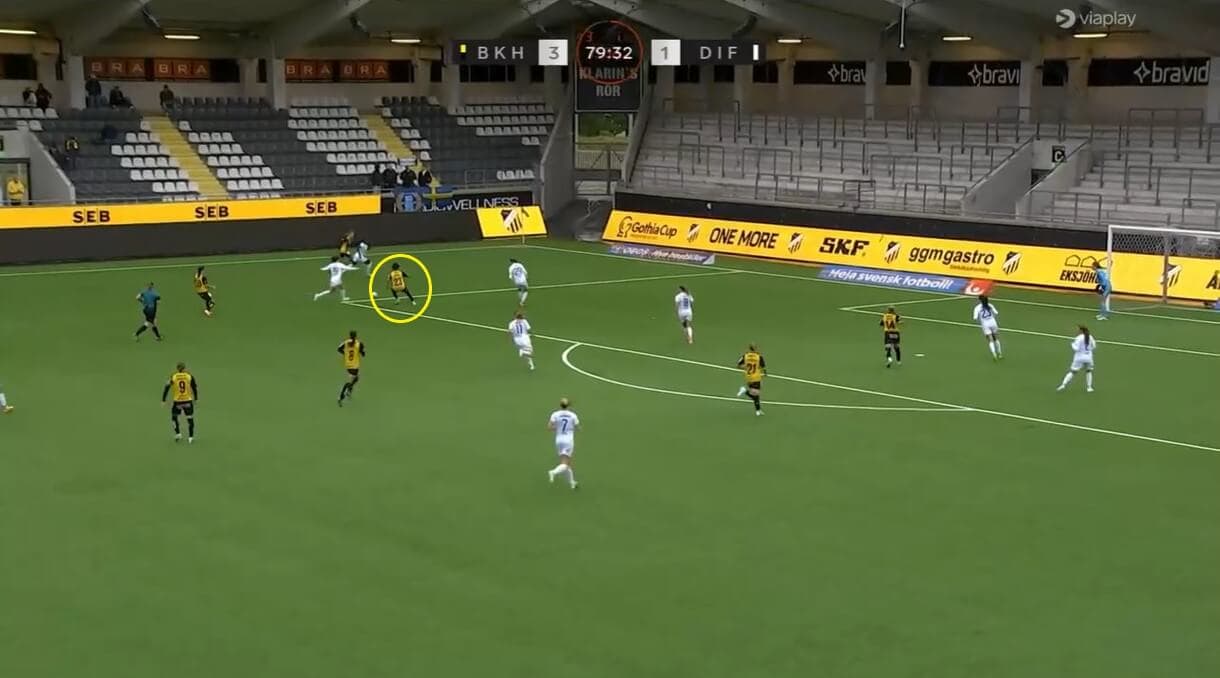
It allows her to operate with a strong flavour of unpredictability whenever she does have the ball at her feet.
She gets into promising areas and then keeps her options open, keeping her opponents guessing whenever she can.
In this case, that is highlighted through Djurgårdens recognising the threat that she poses inside the half-space and moving out to close her down once Hungary’s Anna Csiki passes the ball into her, but not knowing what she will look to do out of crossing the ball into the middle, dribbling it towards the goal line or passing it into a teammate.
As a result, it is hard for them to set up in a way that entirely contains her, and they end up overrunning her, which then gives her the space to manipulate the ball in a way that creates a shooting opportunity from wide.
Whilst the effort might have missed the target on this occasion, the fact that she can test opponents from different angles and positions is clear to see, and it highlights just how threatening she can be to any side coming up against her team.
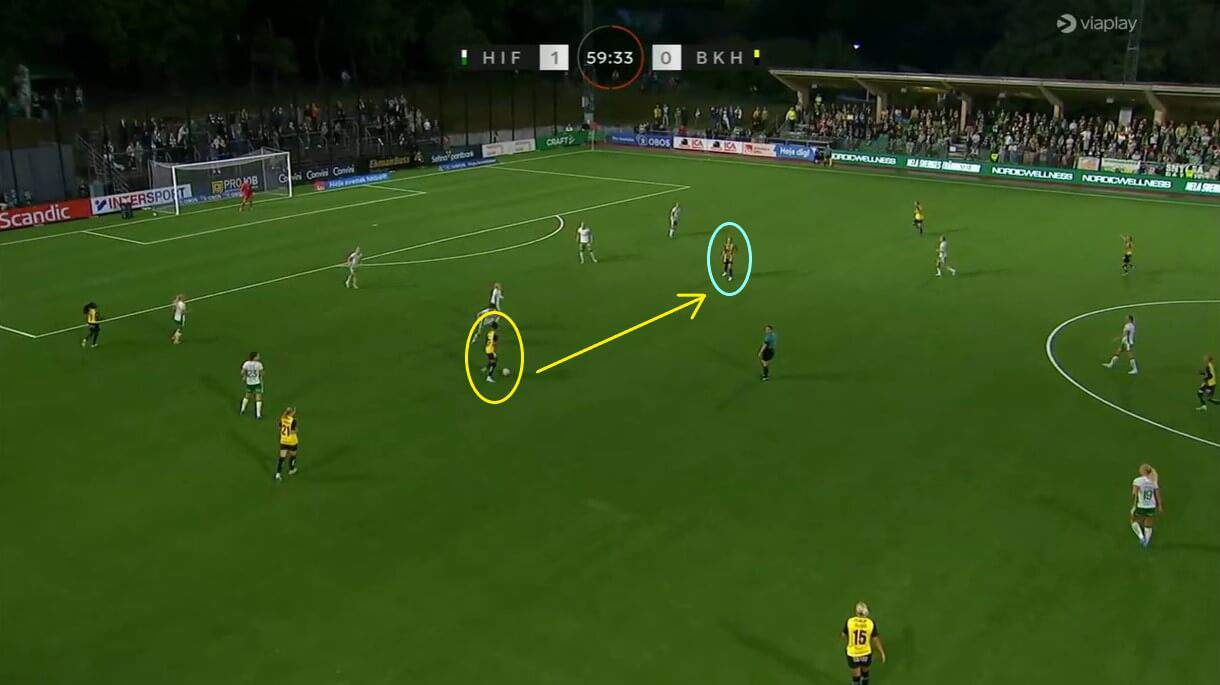
However, what makes Häcken such a tough opponent is that so much of what they do well is about the team and not the individual and every player who features for them needs to be able to recognise when to take matters into their own hands and when it is better to use those around them.
This is something else that Schröder has demonstrated a good understanding of, with this being one situation when she could have had a go herself and had the space to test the goalkeeper.
However, with her recognising that the angle would be too tight and that the shot would require the utmost precision to get beyond every Hammarby Dam player, she instead opted to send the ball across the field and into the path of Sweden forward Anna Anvegård.
The former Everton Women player has more space here because Hammarby’s focus is primarily on Schröder.
The fact that she ended up finding the back of the net from range not only highlights her quality but also indicates that Schröder once again showed a strong sense of judgment in allowing her to get on the scoresheet.
Therefore, the scout report mentions at the beginning that Häcken’s consistency is built on players pulling together and working as one to plug any holes that do get opened up.
It is clear that Schröder fits that mantra and will be a key player for them as the campaign goes on.
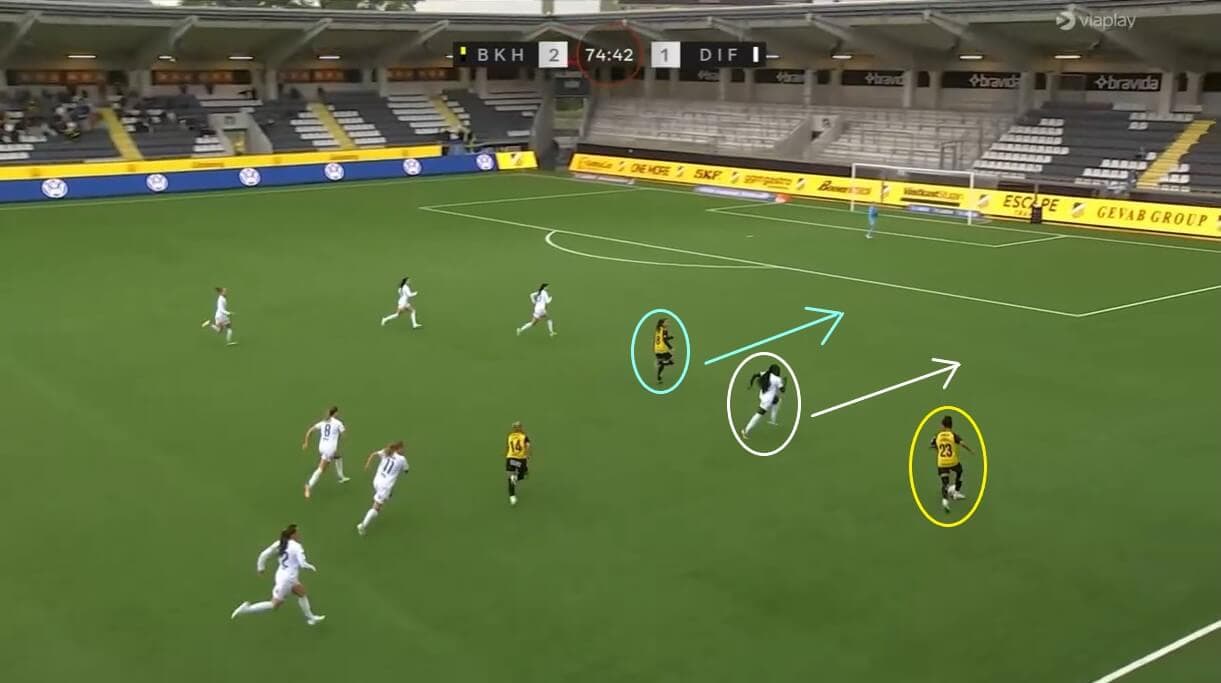
Her ability to play the team game has been demonstrated in other ways, too.
In the match against Djurgårdens, she provided a glimpse of her ability to make clever off-the-ball runs that allow others to get into goalscoring areas.
In this case, she has taken up a wide position on the nearside, and her aim is not to offer a passing option but to once again prevent the defensive line from narrowing.
Her presence has the desired effect, forcing Canada full-back Sura Yekka to stay on her current trajectory rather than inverting her run back towards the middle.
That, in turn, leaves a sizeable gap open for Kafaji to exploit.
It also puts the new Arsenal player in a more favourable position and leads to her scoring here, with only one defender for her to beat in Beata Kollmats rather than the two that she could have faced had Schroder not been positioned outside her.
Felicia Schröder Areas To Work On
Throughout this analysis, it has become clear that a lot of what Felicia Schröder does has a positive impact on her side’s play.
She deserves a lot of praise for the way that she has not only settled into life at first-team level at such a young age but has made herself one of Häcken’s most important players.
However, she is far from the finished article, and there is a lot that she can still improve on as her career progresses.
That potential for her to get even better makes her such an exciting prospect.
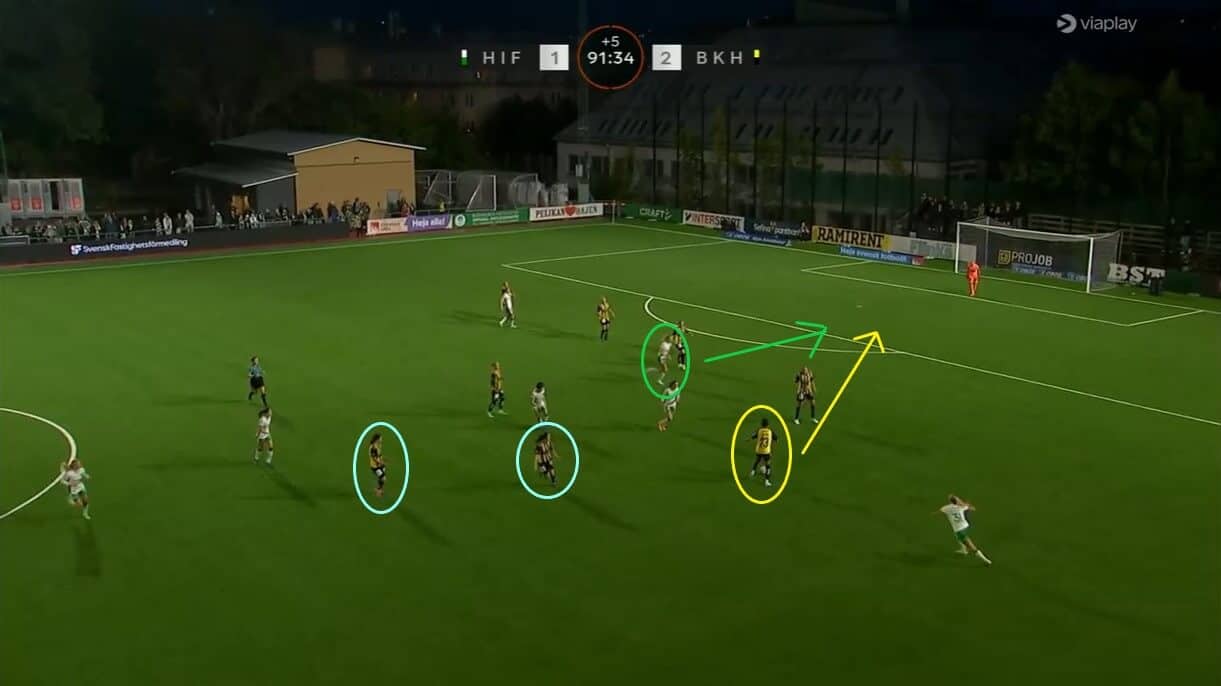
One of the things that does need addressing is her tendency to rush into situations at times and to get her team into difficulty as a result, with it often the case that she will dive into tackles and get taken out of the game or that she will make loose passes that allow opponents to regain the ball cheaply.
In this case, it was an inability to assess her surroundings that let her down, and it was an error that could have been costly for her side.
That is not to say that it was a sequence filled with mistakes.
Her first action was to intercept the pass from Switzerland midfielder Smilla Vallotto and her Hammarby teammate Smilla Holmberg, succeeding in breaking up the defending champions’ attack.
The fact that she has averaged 2.31 interceptions per match highlights how this is not a rarity.
However, it is what happens next that Schröder needs to look at, with her not noticing the space behind her or the dual runs made by teammates Ruby Grant and Hanna Wijk to provide her with forward passing options.
Instead, she opted here to pass the ball back towards her own goal area, but without noticing that Hammarby forward Ellen Wangerheim was in the vicinity and was waiting for a chance like this to come along.
In the end, Häcken did manage to avert the danger, but it was a chance that shouldn’t have come about, and Schröder needs to eradicate it from her game if she is to match her true potential.
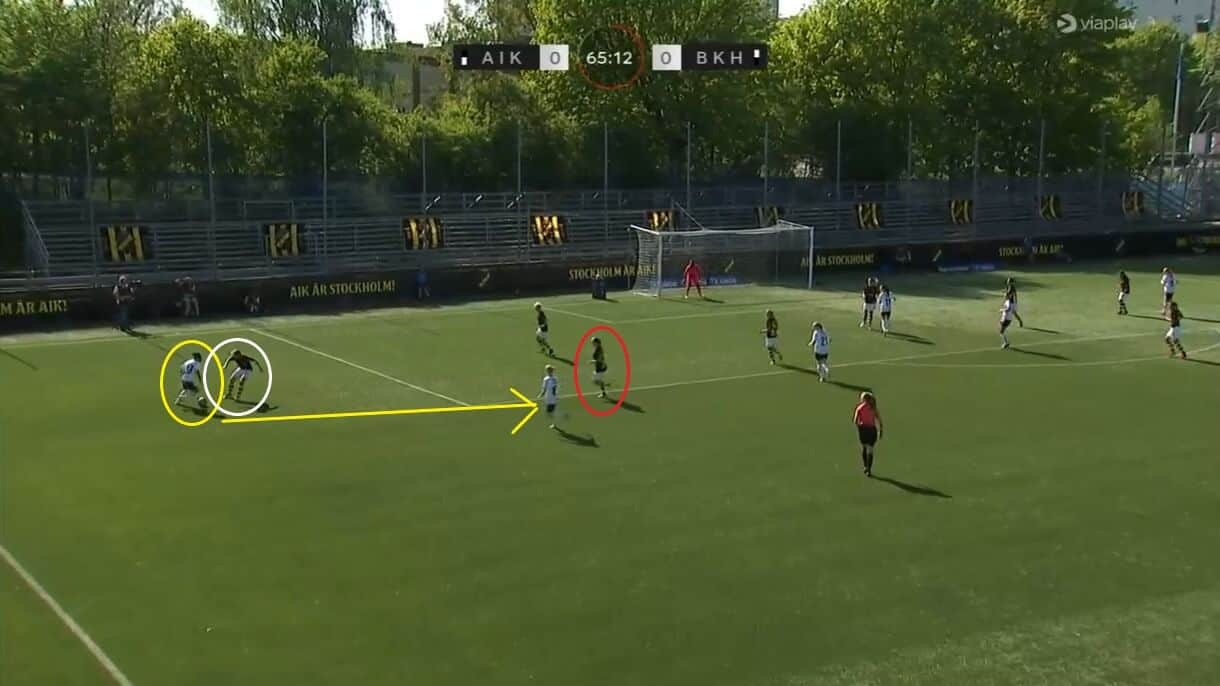
Another aspect that she needs to work on is her decision-making when in wide areas, with it already mentioned that she can make good decisions when playing a role in transitions but not always demonstrating the same sharpness of mind when further out towards the sidelines.
This was one moment when that was made abundantly clear, with her receiving the ball and finding herself in a 1-v-1 situation against AIK Damer’s Maja Johansson and with the potential to move in either direction.
A quick scan of her vicinity would have led to her realising that taking the ball towards the goal line and looking for a cutback or a cross was the better choice, but she didn’t seem to get her head up and instead tried to move in the other direction.
As a result, she found herself in a 2-v-1 against Johansson and Ella Reidy, with AIK regaining the ball and ending the threat.
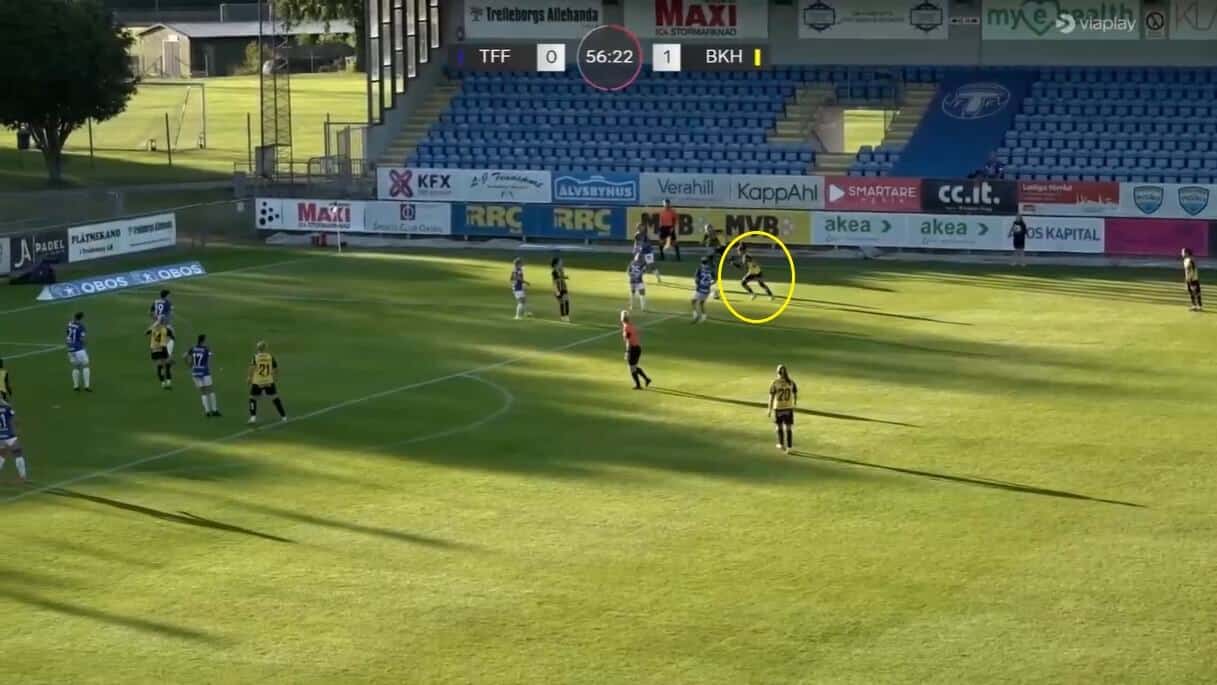
One reason she might not have opted for the cross there is that her general accuracy when sending the ball into the middle is not as high as some might expect, with just 17.6% of her deliveries finding their intended targets.
This match at Trelleborgs Dam in late June was one when she really struggled in this part of the game, with just one of her six crosses finding a teammate.
It is important to note that that wasn’t only down to her, though.
There were times when her opponents failed to read her intentions or the defenders positioned themselves well to win the ball first, but there were some moments when it looked like she and Häcken were in control and when she could have done better when looking to set up a shot on goal.
This was one of those.
Schröder had a trio of potential targets inside the goal area to find but ended up sending the ball over Matilda Nildén, Fossdalsá, and Monica Jusu Bah, allowing Trelleborgs to clear their lines.
In the end, Häcken won this match 2-0, so it wasn’t too damaging that they encountered this issue.
However, the fact that it has been a recurring theme, as indicated by her low success rate, does highlight that it is another aspect of her play that requires attention.
Conclusion
In conclusion, this tactical analysis has looked in detail at BK Häcken Dam forward Felicia Schröder, highlighting the many positive aspects to her play and indicating where she can keep improving as her career goes on.
When breaking down her performances, it has become apparent that she brings a wide range of things to Häcken’s game plan.
She is an attacking player by trade and someone who can be relied upon to have an impact inside the final third, but she is just as capable of dropping back to act as an auxiliary midfielder in transitional moments and of defending both high up the field and whenever her team has come under pressure from their opponents.
Häcken have really come to appreciate that well-roundedness, which is why she will continue to be a prized asset for them as they try to end their domestic season positively and compete in an extended Champions League campaign.
At this moment, there has been no indication of interest elsewhere in Schröder’s services.
However, Scandinavia is a constant conveyor belt of talent and a region that major sides like to hunt in, so it would be surprising if questions were not asked at some point in the near future.
She certainly has a lot of desirable traits in her profile and would fit multiple styles and systems.

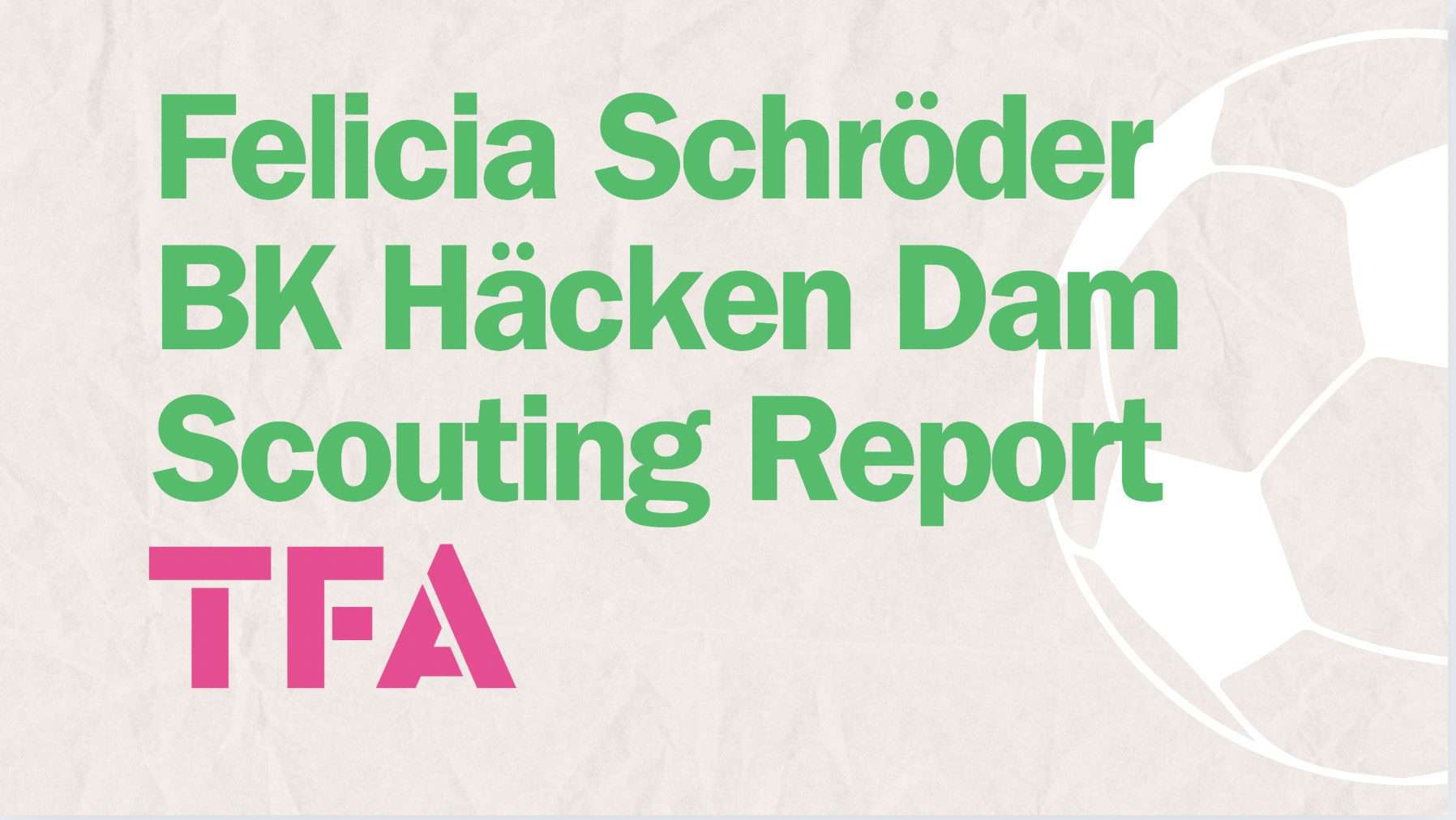



Comments